Recipes from Sarteano: Pici al Ragù Toscano
February 21, 2024
Meet Chef Chiara, the culinary instructor behind our Authentic Tuscan Cooking in the Val d’Orcia Valley and this recipe for Pici al Ragù Toscano! Chef…
Read This Post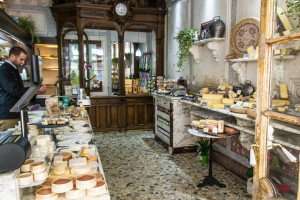 French cheese: a gourmet’s delight, and perhaps one of the seven culinary wonders of the world? (I’ll let you debate the other six.)
French cheese: a gourmet’s delight, and perhaps one of the seven culinary wonders of the world? (I’ll let you debate the other six.)
Everyone knows it’s good, but it’s surprising how many people find it intimidating to face the French cheese selection of their local fine foods store, let alone brave the daunting task of buying cheese at a French market or from a French “fromagère.”
Peruse our culinary vacations in France.
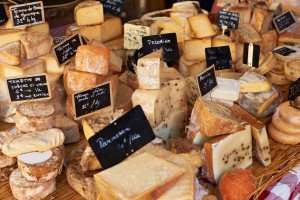 When it comes to French cheese, forget trying to memorize the 300 to 400 distinct cheeses the country has to offer (some say 1000). To make your way through the vast landscape of “fromages français,” start by understanding that each cheese has a regional (often municipal) origin, is made from a specific milk (cow’s, goat’s, sheep’s, or a combination), and each belongs to one of 8 cheese “families”—in French, the “huit familles de fromage”—based on how they are prepared and aged. Because the regional designation and types of milk are the easiest to decipher, we’ll break down the lesser-known category, the “eight families”:
When it comes to French cheese, forget trying to memorize the 300 to 400 distinct cheeses the country has to offer (some say 1000). To make your way through the vast landscape of “fromages français,” start by understanding that each cheese has a regional (often municipal) origin, is made from a specific milk (cow’s, goat’s, sheep’s, or a combination), and each belongs to one of 8 cheese “families”—in French, the “huit familles de fromage”—based on how they are prepared and aged. Because the regional designation and types of milk are the easiest to decipher, we’ll break down the lesser-known category, the “eight families”:
Learn more about French cheeses on a cooking vacation.
 1) Fromages frais (Fresh cheeses)
1) Fromages frais (Fresh cheeses)These are what you would expect, cheeses that have not been cooked, pressed, aged, but are served young, sometimes minutes away from being actual milk. They are “wet” and tend to be very mild in flavor. Some examples? Le petit Suisse and Brousse, although some might be more familiar with an Italian example: ricotta.
Soft cheese with a soft, white, floury rind, usually made from cow’s milk. They are aged about a month, and famous examples are Camembert and Brie.
Try Camembert on a fabulous culinary tour in culinary tour in Normandy.
 3) Fromages à pâte molle et à croûte lavée (Soft cheeses with a washed rind)
3) Fromages à pâte molle et à croûte lavée (Soft cheeses with a washed rind)The famed “stinky” cheeses, they are soft, sometimes gooey and pack a lot of flavor. They are made of cow’s milk, and are washed as they are aged to prevent the development of surface mold. Examples: Epoisses, a personal favorite, Reblochon, and Munster.
Cheese 101: How it’s made and what makes it so good.
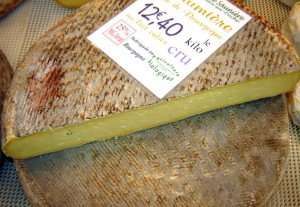 4) Fromages à paˆte pressée (Pressed cheeses)
4) Fromages à paˆte pressée (Pressed cheeses)These cheeses are, as the name implies, “pressed,” which drains the moisture from the cheese, but they are also aged for several months under carefully controlled conditions which include washing the rinds and turning the cheeses to develop a uniform rind. Examples are Cantal, Saint-Nectaire, Morbier, and Ossau-Iraty.
These hard varieties are made from heating the cheese curd before pressing it, then forming the cheese into wheels and ripening them for a long time. They are mostly associated with the mountainous areas of France, and examples are Comté, one of France’s most popular cheeses, Beaufort, Emmental, and Gruyère.
How to make a delicious cheese and wine course.
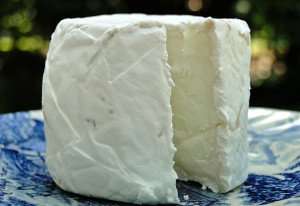 6) Fromages de chèvre (Goat’s milk cheeses)
6) Fromages de chèvre (Goat’s milk cheeses)It is interesting that only goat’s milk cheese merits its own “family,” especially as there is a lot of diversity in how goat’s milk cheeses are made (fresh, for example, versus with a washed rind, etc.). They are usually soft cheeses, and among the many examples are: Mâconnais, Selles-sur-Chere, Crottin de Chavignol, and Pouligny-Saint-Pierre.
 7) Fromages à pâte persillées (Blue Cheeses)
7) Fromages à pâte persillées (Blue Cheeses)Blue cheeses are the easiest to spot because of their distinctive and colorful marbling. They are made from cow’s or sheep’s milk and are ripened in dark, humid caves for long periods and have strong, salty flavors and smells. The most famous example is Roquefort (one of the few made from sheep’s milk), but others are Bleu de Bresse, Bleu d’Auvergne and Fourme d’Ambert.
See our Paris cooking classes.
This does not mean Velveeta — the processed cheeses are indeed cheese, made of milk, but are prepared by blending other cheeses together and sometimes mixing them with herbs, garlic, or other aromatics. They are soft and spreadable. The most known example is probably Boursin.
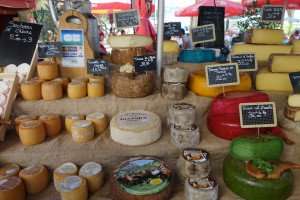 Before venturing off to buy cheese, it helps, of course, to know ahead of time what your tastes are: do you prefer a washed rind cheese, or a pressed cheese? Blue or goat? But whether you are on a cooking vacation visiting the market in St. Remy, at a fromagerie in Paris, or even at your local Whole Foods, you now have the tools to start the cheese conversation!
Before venturing off to buy cheese, it helps, of course, to know ahead of time what your tastes are: do you prefer a washed rind cheese, or a pressed cheese? Blue or goat? But whether you are on a cooking vacation visiting the market in St. Remy, at a fromagerie in Paris, or even at your local Whole Foods, you now have the tools to start the cheese conversation!
By Peg Kern
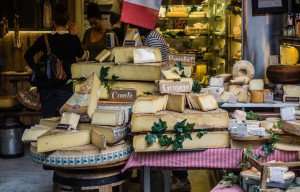 Find more photos, videos, food facts, and travel stories from The International Kitchen on Facebook, Instagram, Pinterest, Twitter, and YouTube.
Find more photos, videos, food facts, and travel stories from The International Kitchen on Facebook, Instagram, Pinterest, Twitter, and YouTube.
Search our blog for more chef interviews, recipes, and destinations features.
Sign up to receive our newsletter, which includes travel tips, recipes, promotions, and information on our best culinary vacations.